Speech Australia's Economic Transition – State By State

Christopher Kent[*]
Assistant Governor (Economic)
Australian Business Economists Conference Dinner
Sydney –
Introduction
I am grateful for the opportunity to address you all this evening. It is fitting for my final speech in my capacity as the Bank's chief economist to be in front of such a pre-eminent group of Australia's business economists.
I want to talk about Australia's economic transition following the end of the resources boom. My focus will be on developments affecting broader economic conditions, and the labour and housing markets more specifically. A key theme of my discussion is that aggregate, economy-wide variables – such as investment, unemployment or housing prices – often mask important differences across the states. Understanding those differences can give us a better appreciation of how the Australian economy is performing and is likely to evolve.
Before focusing on those differences, though, I'll start with an overview of the overall economy.
About two weeks ago, we published our updated forecasts. The flow of data over recent months had been broadly in line with our earlier expectations and so the forecasts were generally little changed.
The economy continues to adjust to the end of the resources boom (Graph 1). Our expectation is that GDP growth will be close to potential growth over the next few quarters and pick up to be a little above potential thereafter. The unemployment rate, which has declined over the past year by more than expected, is likely to edge just a little lower over the next two years. That implies that there will be some spare capacity in the labour market for a time. Inflation is low. In year-ended terms, we expect underlying inflation to remain around 1½ per cent for a few quarters before gradually increasing to more normal levels. That profile follows from the forecast for the growth of labour costs to rise gradually and is consistent with the medium-term inflation target.
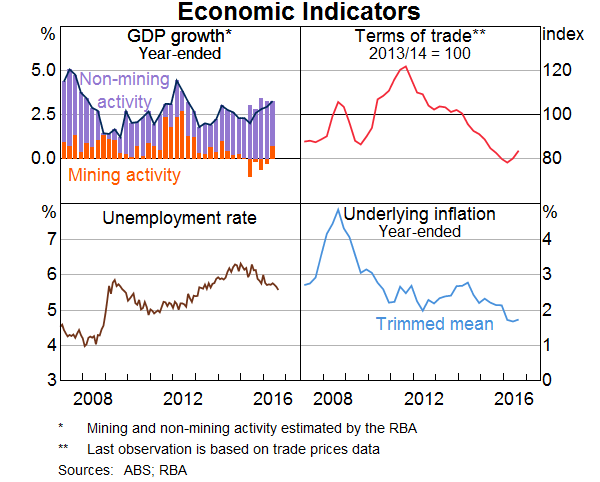
Two key forces shaping developments over recent years have been the large fall in mining investment and commodity prices. Mining investment has a bit further to fall, but by our estimates about 80 per cent of the adjustment is now behind us. Resource exports still have further to grow. Meanwhile, growth of activity in the non-mining sector has risen gradually over recent years. That improvement has been fostered by low interest rates and the depreciation of the exchange rate since 2013. Growth of non-mining economic activity is expected to be around average over the next two years.
One notable aspect of our latest forecasts was the upward revision to the outlook for Australia's terms of trade. Prices of bulk commodities have risen this year and contributed to a rise in the terms of trade of about 6 per cent in the June and September quarters. That's the first rise in the terms of trade in some time. Our forecasts are for the terms of trade to remain above the low point reached earlier this year (and about 25 per cent above the average of the early 2000s before the boom). While our forecasts are uncertain and subject to various risks, the upward revision represents a marked change from the pattern of the past five years. Our assessment, based in part on liaison information, is that the improved outlook for commodity prices is not likely to lead to a noticeable pick-up in mining investment (in the near term at least). Even so, if our forecasts are right, the terms of trade will shift from the substantial headwind of recent years to a slight tail breeze providing some support to the growth of nominal demand.[1]
Having set the scene on the national economy, I now want to switch attention to the differences across the states. Outcomes across the country have varied in large part because the effects of the end of the resources boom are quite different across industries. The economies of the mining states – Western Australia and Queensland – have been most directly affected by the sizeable declines in mining investment and commodity prices over recent years. Mining investment is relatively intensive in its use of labour. Putting the mining infrastructure in place drew upon workers with a range of construction and engineering skills. It also employed people with skills that we wouldn't normally associate with mining, in industries such as business services, transport and manufacturing. Many of those people didn't work on site, but were based in other parts of the state (and in some cases, beyond that).[2] Whether or not they were on- or off-site, people were well rewarded for their work on mining-related projects. In response to those opportunities, there was a large rise in population growth in the mining states. Much of the spending undertaken by the new and highly paid workers found its way into the local economies, further boosting economic activity.
However, mining production does not require much labour, so it has not been surprising that the shift from the investment to the production phase of the resources boom has seen a decline in the growth of nominal income in the mining states and a sharp decline in population growth. Also, the large fall in commodity prices (since the peak in 2011) weighed on mining profits, wages and fiscal revenues, further dampening the growth of nominal incomes in the mining states (and beyond).
At the same time, states with less exposure to mining – New South Wales, Tasmania and Victoria – have seen an improvement in their economic conditions; and, in Victoria's case, a persistent rise in population growth. Those states have clearly benefited from the effects of low interest rates, which have boosted conditions in their housing markets and helped to support demand more generally. The decline in the exchange rate since 2013 has also aided their trade-exposed industries, including tourism, education, business services and agriculture. South Australia's performance lies somewhere between the large mining and non-mining states. More recently, the Queensland economy has fared better than that of Western Australia, in part because the fall in mining investment has been more advanced in Queensland. In addition, Queensland has had the advantage of its sizeable exposure to the education and tourism industries.
Economic Conditions and Business Investment
This ranking of the states I have just described is evident in the NAB survey of business conditions (Graph 2). Starting around four or so years ago, surveyed conditions in most states have been on an upward trend. They are now generally above average, with conditions strongest in the south-east of the country. Western Australia is the obvious exception; conditions there have declined from above average, when mining investment and commodity prices were on the rise, to well below average of late.
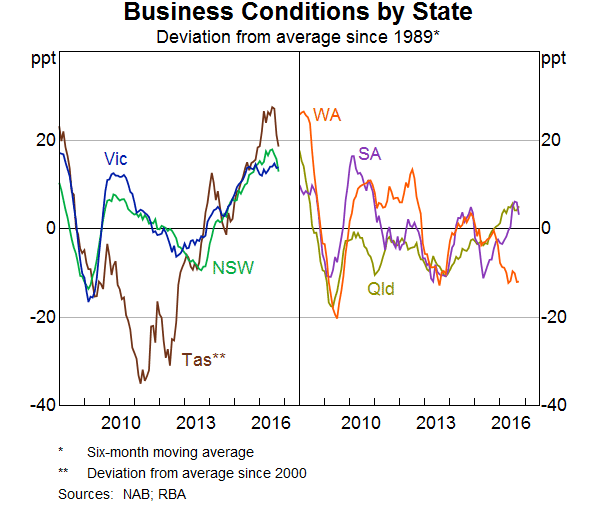
A similar ranking of economic conditions is apparent in the growth rate of household consumption. Consumption growth has generally been stronger in the south-east over the past few years and weaker in the mining states (Graph 3).
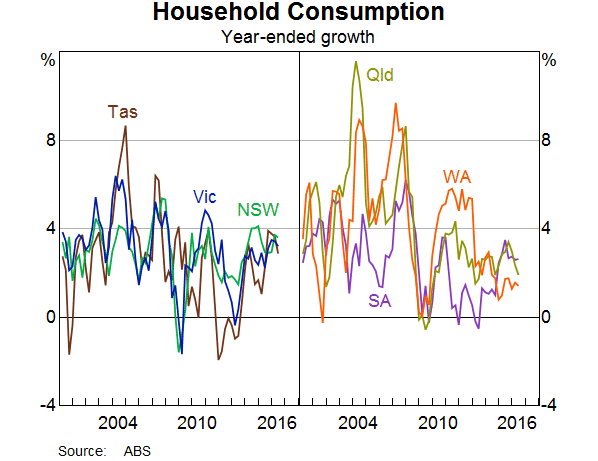
Considering these sorts of differences across the states can enhance our understanding of the behaviour of some economy-wide aggregates. Non-mining business investment provides a good example of this point.
For the country as a whole, non-mining business investment has been little changed since the onset of the global financial crisis (Graph 4). Growth of non-mining business investment had been relatively strong prior to that, averaging about 10 per cent per annum over the six years to 2007/08. It has increased a little since the peak in mining investment – by an average of 3 per cent per annum. But growth has been less than might have been expected given the support to overall demand provided by low interest rates and the depreciation of the exchange rate.
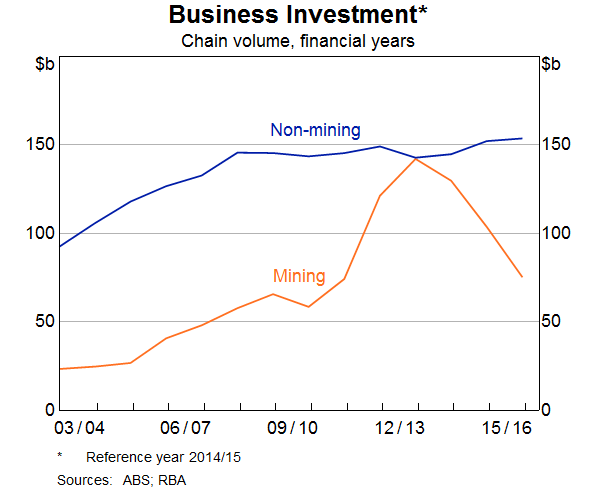
We have gone to some lengths to try to understand why non-mining business investment has been subdued over recent years.[3] Prominent among the list of explanations are: a high level of uncertainty and a low appetite for risk taking within the business community; low productivity growth; and the growing importance of service industries (which are less capital intensive). While such explanations all have some merit, there's an additional perspective that becomes apparent once we look at the differences across the states.
The ABS survey of firm's capital expenditure provides a sense of how non-mining business investment has varied across the states (Graph 5).[4] It shows that non-mining business investment has been growing over the past three years in New South Wales (by an average of about 10 per cent per annum). Victoria has also seen some growth of late. The outcomes in these states accord with information from the Bank's business liaison program; firms in these states appear willing to invest in response to stronger business conditions. Meanwhile, non-mining business investment has been little changed in Queensland for some years, while it has declined in Western Australia since the peak in the resources boom. This is broadly consistent with the behaviour of demand across the states.
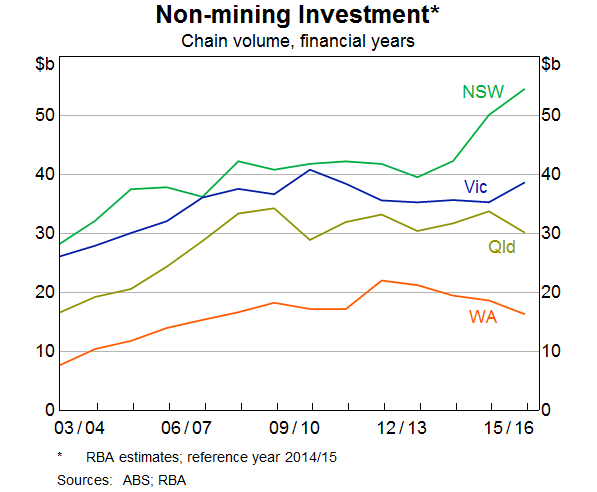
So while non-mining business investment overall has been subdued, it is not right to say that Australian businesses have been reluctant to invest. Investment has increased to some extent in parts of the country, aided by favourable financing conditions and in response to strengthening demand. But firms have not been willing to increase investment in the mining states, and have even reduced investment in Western Australia, where demand has been particularly weak.
Labour Market
The unemployment rate has declined over the course of this year, to be about ½ percentage point below the peak in 2015. However, that decline is likely to have overstated the extent of the improvement in labour market conditions. That is because, over the same period, employment growth has moderated and part-time jobs have accounted for all the growth in employment (Graph 6). Moreover, the rate of underemployment has increased a little over the past year. That is, there has been a rise in the share of employees who would like to work more hours than they do. They represent additional spare capacity.
A rising share of part-time employment has been a structural feature of the economy over recent decades, reflecting both demand- and supply-side factors.[5] But the growth of full-time employment has been quite subdued since 2012, rising only briefly above its 20-year average of 1.3 per cent per annum.
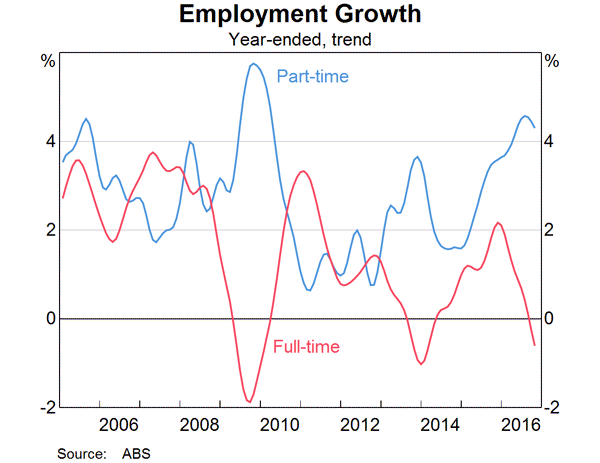
Once again, the national outcome obscures contrasting experiences across the mining and non-mining states. During the mining investment boom, full-time employment grew strongly in the mining states, whereas it was little changed across the rest of the country (Graph 7).[6] Labour was going to where it was in greatest demand and being paid relatively handsomely – in both mining and non-mining sectors in the mining states (see below).
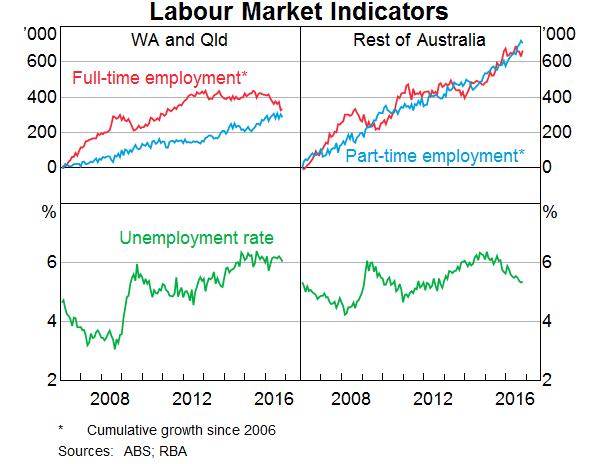
Since 2012, however, the situation has reversed. Full-time employment in Western Australia and Queensland hasn't increased and the unemployment rate across those two states has risen noticeably. That makes sense. From 2012, mining investment and commodity prices were in sharp decline. In addition to the retrenchment of mining-related employment, those forces have also had a noticeable knock-on effect to non-mining industries in those states, as the buoyant effects of strong growth of the population and household expenditure have been unwound in concert with conditions in the mining industry. The decline in full-time employment over 2016 appears to reflect a further decline in demand conditions within the Western Australia economy. One important part of that, the property market, has become progressively weaker, as I'll discuss in a minute. Moreover, wages appear to be adjusting to bring wage levels back towards those of the other states (Graph 8). Part of that adjustment is occurring via a decline in wages in the mining sector relative to wages in other sectors. Liaison reports suggest that wage pressures will be quite subdued in the mining states for a time. As that adjustment occurs, it will weigh on the growth of nominal demand in the mining states.

Interestingly, full-time employment in the non-mining states remained weak up until about 2014. Thereafter, those states have benefited not only from the decline in interest rates, but also from the positive effect on their tradable industries from the depreciation of the exchange rate that started from early 2013. The forward-looking indicators for employment – job advertisements and job vacancies – suggest that employment will grow moderately in the non-mining states in the months ahead but remain weak in the mining states. Again, like non-mining investment, the aggregate picture of employment masks some important divergences across the states.
To a certain extent, the different employment outcomes across the states have been mirrored in the behaviour of unemployment rates. However, population growth has also responded to changes in demand conditions in the labour market.[7] Population growth slowed quickly in the mining states from what had been quite rapid rates (Graph 9). Some of that slowdown was the natural result of temporary workers – who had helped to build the new mining infrastructure – taking their skills elsewhere as projects were completed. The other margin of adjustment wasn't so much an outflow of residents, but rather a halting of the inflow, including from New Zealand. In any case, the slowdown in the growth of the population in the mining states has meant that the unemployment rates there have gone up by less than would otherwise have been the case. Meanwhile, population growth has picked up over recent years in the south-eastern states, in line with the improvement in measures of business conditions and demand. Changes in population growth have also had important implications for conditions in the housing market.
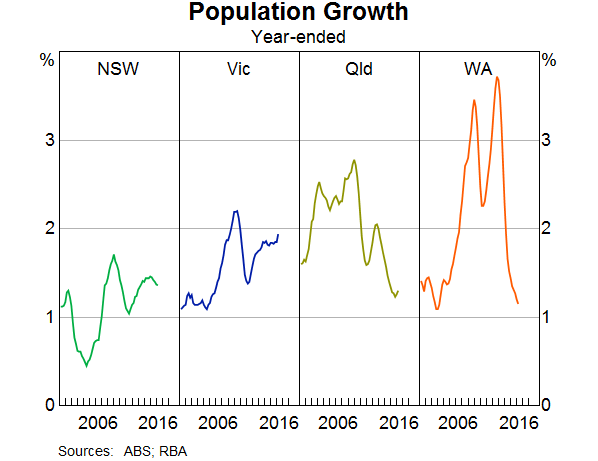
Housing Market
As we noted in the latest Statement on Monetary Policy, conditions in the established housing market have eased relative to a year ago. Let me be clear though: that doesn't mean that the risks associated with high levels of house prices and housing debt have diminished. It does mean that those risks are not building to the same extent as last year. That's because housing prices are growing less quickly than they were in 2015 and housing credit growth has also slowed. Importantly, much of that change followed from the earlier actions of the Australian Prudential Regulation Authority and the Australian Securities and Investments Commission, which led to an appreciable tightening in lending standards.[8]
The November Statement also discussed some indicators that suggest that conditions in housing markets may have strengthened over recent months. In particular, housing price growth has picked up in Sydney and Melbourne, where auction clearance rates have increased to high levels. In addition, loan approvals to investors have increased over recent months.
In contrast to Sydney and Melbourne, housing market conditions remain subdued in Perth. Prices of apartments and detached dwellings there have declined further and are around 8 per cent below the peak. Rents in Perth have also declined by about the same amount. Those changes are consistent with the weakening in general economic conditions in Western Australia. Moreover, as the graph above shows, population growth in Western Australia has declined significantly since the peak of mining investment in 2012. And yet the full extent of the decline in population growth may not have been readily appreciated by buyers and builders of housing. That would be consistent with the fact that building approvals in Western Australia actually picked up noticeably from 2012 and did not peak until 2014, which was also about the same time that housing prices and rents reached a peak in Perth. This meant that the housing supply was still ramping up at the same time that population growth was declining. This is apparent in the following graph, which shows the growth in the number of people in each of the large states relative to the number of new dwellings completed at that time (Graph 10). The ‘dashes’ show the average number of people per household from the various censuses.[9]
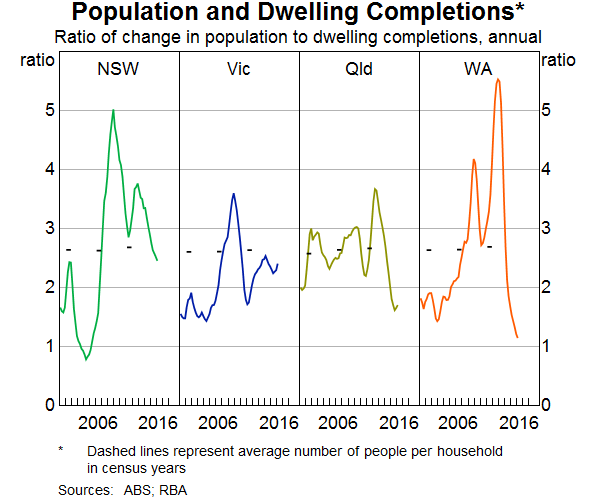
In Western Australia, this ratio has fallen sharply to about one additional person in the state per new dwelling completion. That's well below the average number of inhabitants per dwelling. In other words, there are a lot of dwellings being completed relative to the needs of the slower growing populace. That is consistent with the sharp rise in vacancy rates in Perth and the adjustment to rents and housing prices. It also suggests that dwelling construction and construction employment are likely to remain subdued for some time. That is having a knock-on effect to other industries linked to the property market. These linkages are one way in which the decline in the resource sector has been extended and amplified through to other parts of the economy.[10]
Before concluding, I'll make a brief observation on the difference between the strong (and rising) population growth in Victoria over recent years and the lower population growth in New South Wales. Victoria is now the beneficiary of net inward migration from each of the other states and a larger contribution from net overseas immigration, compared with its past and compared with New South Wales currently. It strikes me that it's possible that these contrasting outcomes across Australia's two most populated states owe in part to the relatively high cost of housing and longer commute times in Sydney (and its surrounding areas) compared with Melbourne.[11] Also, as Graph 10 suggests, the housing supply in Victoria has expanded at a relatively brisk pace, enabling the state to accommodate the relative strong growth of its population over recent years.[12]
Conclusion
In a country as large and diverse as Australia, the behaviour of the economy as a whole often misses important differences across the country:
- The modest growth of non-mining business investment over recent years masks the stronger growth in some parts of the country and declines in others.
- The weakness in full-time employment nationally over the past few years owes much to the subdued demand for labour in the mining states.
- And housing market conditions are far from uniform. Prices are falling in Perth after a ramp up in supply combined with a fall in population growth. Meanwhile, Melbourne is seeing stronger population inflows, perhaps benefiting from strong growth of supply for some years and lower prices than in Sydney.
These are a few examples of how the experiences of the different states and industries can provide useful insights into the behaviour of the overall economy. The Bank puts time and resources into understanding these sorts of differences across regions and industries. We examine a range of publicly available data and build on that knowledge through our extensive liaison program. While the Bank sets monetary policy for the nation, an appreciation of the different parts gives us more confidence about our understanding of the behaviour of the whole.
A key reason for the differences across the states over recent years has been the effect of the large declines in mining investment and commodity prices. These have contributed to weaker economic conditions in the mining states and, therefore, weighed on economic conditions nationally. But those forces are waning; indeed, the terms of trade have even risen of late. Hence, there are reasonable prospects for stronger growth of nominal demand in the mining states and, by extension, for the economy overall. That would contribute to a rise in domestic inflationary pressures and a gradual return of inflation to more normal levels. In conclusion, a close examination of the differences across the states can shed some light on the outlook for the Australian economy.
Endnotes
I thank Sean Langcake and Merylin Coombs for invaluable assistance in preparing these remarks. [*]
For a detailed discussion of the terms of trade and its economic effects over recent years, see Kent C (2016), ‘After the Boom’, Speech at Bloomberg Breakfast, Sydney, 13 September. [1]
For a detailed analysis of this point, see Rayner V and J Bishop (2013), ‘Industry Dimensions of the Resource Boom: An Input-Output Analysis’ RBA Research Discussion Paper No 2013-02. [2]
For example, see Kent C (2014), ‘The Business Cycle in Australia’, Address to the Australian Business Economists, Sydney, 13 November; Kent C (2014), ‘Non-mining Business Investment – Where to from here?’, Address to the Bloomberg Economic Summit, Sydney, 16 September; Lane K and T Rosewall (2015), ‘Firms' Investment Decisions and Interest Rates’, RBA Bulletin, June, pp 1–8; Lowe P (2013), ‘Investment and the Australian Economy’, Address to the CFA Australia Investment Conference, Melbourne, 24 October. [3]
These estimates apply the share of non-mining capital expenditure by state from the ABS capital expenditure survey to the national accounts measure of non-mining business investment. [4]
For a more detailed discussion of the growth of full-time and part-time employment, see RBA (2016), ‘Box B: Trends in Part-time and Full-time Employment’, Statement on Monetary Policy, November, pp 36–38. [5]
As we highlighted some time ago, the relatively high real exchange rate provided a clear signal for labour and other productive resources to shift towards the resources sector from other parts of the tradable sector. See Plumb M, C Kent and J Bishop (2013), ‘Implications for the Australian Economy of Strong Growth in Asia’, RBA Research Discussion Paper No 2013-03. [6]
In addition, the participation rate has declined noticeably in the mining states to be back around levels prior to the resources boom. That trend is driving the national participate rate lower; participation in the rest of the country has been little changed since peaking around the time of the global financial crisis. [7]
For a detailed discussion of this point, see RBA (2016), Financial Stability Review, October. [8]
When the ratio of population growth to the number of dwelling completions is below the average number of people per household, this will tend to contribute to a decline in the average number of people per household over time. However, some dwelling completions will become vacant dwellings (i.e. second homes) so the census measure of people per household will tend to be higher than the ratio of population growth to net dwelling completions. [9]
In Brisbane, the cooling of the property market has to date been less pronounced than in Western Australia, which probably owes to the Queensland economy being a bit more diversified than that of Western Australia as well as its geographic proximity to Sydney and Melbourne. Brisbane apartment prices have fallen of late, but house prices have continued to rise. Like Western Australia, completions in Queensland are currently running ahead of the needs of the growing population based on the recent average number of inhabitants per dwelling. [10]
Median housing prices in Melbourne are currently about $770,000 versus $1.077 million in Sydney. These differences don't appear to be accounted for by differences in incomes; data from the HILDA survey show that in 2014, median annual household incomes were $89,865 and $87,913 in the two cities, respectively. ABS data suggest income per capita is higher in New South Wales than Victoria, but the ratio of New South Wales to Victorian income per capita is lower than the ratio of median house prices in their respective capital cities (1.16 against 1.40). Furthermore, Sydneysiders, on average, also spend a bit longer commuting to work; HILDA data from 2014 show that the average time spent commuting to work per week is 5 hours 13 minutes in Sydney and 4 hours 56 minutes in Melbourne. [11]
In part, the strength of dwelling completions in Victoria might reflect that fact that Melbourne does not have the same geographic constraints that Sydney does. Also, inner-city Melbourne (but not the next ring of suburbs out) has had more liberal building regulations. For a further discussion, see RBA (2015), ‘Submission to the Inquiry into Home Ownership’, House of Representatives Standing Committee on Economics, 25 June. [12]